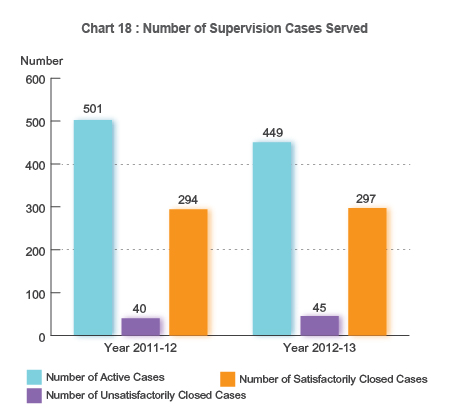OBJECTIVES
11.1
The overall objective of services for offenders under SWD is to give effect to the directions of the courts on the treatment of offenders by social work approaches through community-based and residential services with a view to re-integrating offenders into the community.
SERVICE PROVISION
11.2
The service provision as at 31 March 2013 is as follows:
- 1 High Court and District Court Probation Office
- 7 Probation and Community Service Orders Offices
- 1 Co-ordinating Office of Community Service Orders
- 6 Social Service Centres for Ex-offenders
- 6 Hostels for Ex-offenders
- 1 Correctional/Residential Home
- 1 Young Offender Assessment Panel
- 1 Post-Release Supervision of Prisoners Scheme
Community-based Rehabilitation Services
11.3
With a view to generating more synergy, streamlining service delivery, providing a one-stop service for customers and adopting a holistic approach to better meet rehabilitation needs of offenders, SWD completed a review on the community-based services for offenders, which includes Probation Service, Community Service Orders (CSO) Scheme and Community Support Service Scheme (CSSS). The new integrated model took effect on 3 July 2012.
11.4
Under the model, the 11 then Probation Offices were integrated with the CSO Office and the two Community Support Service Centres and re-organised into seven Probation and Community Service Orders Offices (PCSOs), each of which serves its respective Magistrates' Courts. The seven PCSOs are responsible for all statutory duties including preparing court reports on offenders' suitability for and providing statutory supervision as well as group work service to offenders placed under probation or CSO supervision.
11.5
A Co-ordinating Office of Community Service Orders (COCSO) was also set up to support the seven PCSOs in identifying and co-ordinating work projects, and liaising with Probation Officers on work site performance of offenders placed under the CSO.
11.6
The number of supervision cases served under Probation Service and CSO Scheme for 2011-12 and 2012-13 are shown in Charts 14 and 15 respectively as follows:
Probation Service
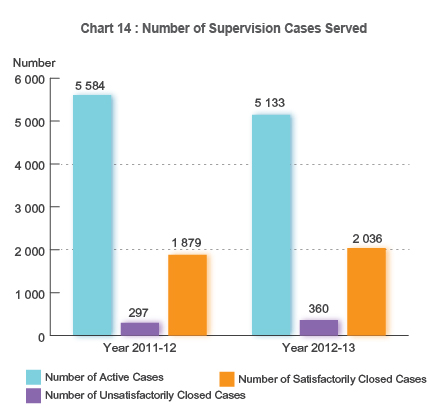
Community Service Orders Scheme
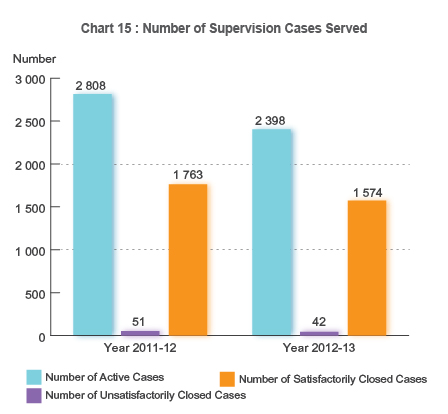
Pilot Project on Enhanced Probation Service
11.7
Upon recommendation of the Task Force on Youth Drug Abuse in its report promulgated in November 2008, a two-year Pilot Project on Enhanced Probation Service (the Project) has been implemented since October 2009 at the two probation offices serving the Kowloon City Magistrates' Courts and the Kwun Tong Magistrates' Courts to provide more focused, structured and intensive treatment programmes for young offenders aged below 21 and convicted of drug-related offences pursuant to the Probation of Offenders Ordinance, Cap. 298. As at 31 March 2013, 601 social enquiry cases were referred by the two magistrates' courts, among which 259 offenders aged below 21 and convicted of drug-related offences were put on probation supervision under the Project. In view of the effectiveness of the Project as revealed in an evaluation in May 2012, enhanced probation service will be extended territory-wide to cover all the seven Magistrates’ Courts in 2013-14.
CORRECTIONAL/RESIDENTIAL HOME
11.8
SWD provides residential service and rehabilitation training for juvenile offenders and children in need of care or protection in a purpose-built training complex, the Tuen Mun Children and Juvenile Home, with a capacity of 388. It serves the statutory functions of a place of refuge, a remand home, a place of detention, an approved institution (probation home) and a reformatory school. The number of admissions to place of refuge/remand home/place of detention for 2011-12 and 2012-13 are 2 491 and 2 125 respectively. The number of discharged cases for the approved institution (probation home) and reformatory school for 2011-12 and 2012-13 is shown in Chart 16 as follows:
Approved Institution (Probation Home) and Reformatory School
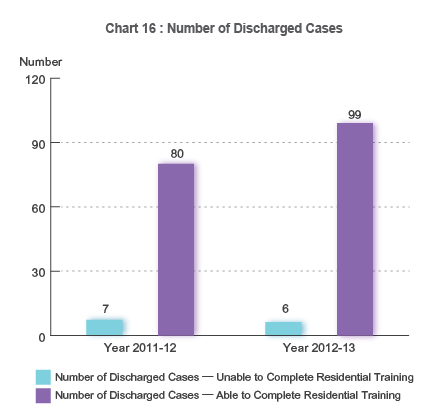
JOINT VENTURE WITH THE CORRECTIONAL SERVICES DEPARTMENT
11.9
The two services operated in joint venture with the Correctional Services Department for young offenders and adult discharged prisoners are the Young Offender Assessment Panel and the Post-Release Supervision of Prisoners Scheme respectively. The number of cases served by the two services are shown in Charts 17 and 18 respectively as follows:
Young Offender Assessment Panel
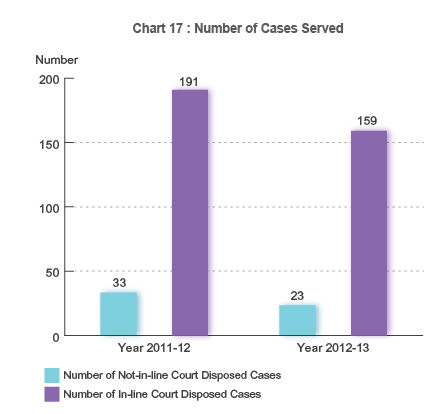
Post-Release Supervision of Prisoners Scheme
